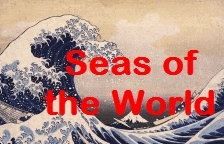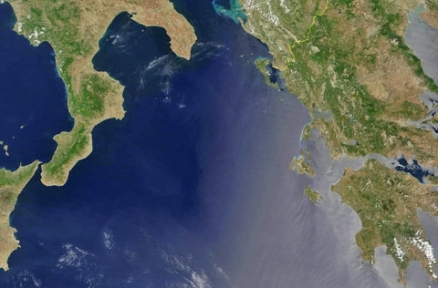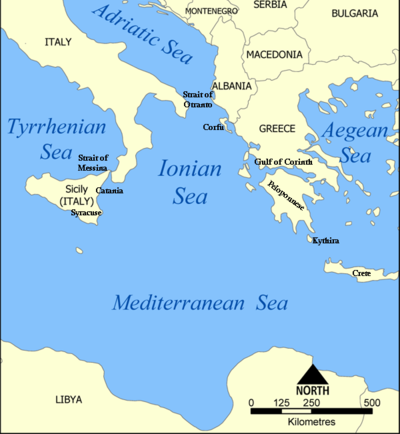Ionian Sea
Seas of the World  The Ionian Sea is part of the Mediterranean Sea between Italy and Greece immediately south of the Strait of Otranto and Adriatic Sea.
The Ionian Sea is part of the Mediterranean Sea between Italy and Greece immediately south of the Strait of Otranto and Adriatic Sea.
The the southern limit of the Ionian Sea sometimes cited as an arc extending from the southern tip of Sicily to the Peloponnese Peninsula (Kythira just south of the Peloponnese), while others extend the sea to the coast North Africa.
The Strait of Messina between Sicily and the Italian mainland connects it to the Tyrrhenian Sea which lies off the west coast of Italy.
The sea includes the Ionian Islands of Corfu, Paxos, Lefkada, Ithica, Kefallonia, Zakynthos and Kythira..
The Gulf of Corinth extends from the Ionian Sea deep into the Greek mainland and forms the northern boundary of the Peloponnese peninsula.
Water and Circulation
The major water masses of the Ionian Sea are Modified Atlantic Water (MAW), Levantine Intermediate Water (LIW), and Eastern Mediterranean Deep Water (EMDW). The MAW spreads eastward from the Sicily Straits in the surface layer and is identified as a subsurface salinity minimum between 30 and 200 metres (m) depth. It overlies the LIW that enters through the Cretan passage and is identified by a salinity maximum between 200 and 600 m depth. Below this, the colder and less saline EMDW, the main source of which is Adriatic Deep Water (ADW), occupies the layers below 1600 m. A transitional mixture of LIW and EMDW occupies the range between 700 and 1600 m. In the summer Ionian Surface Water can be differentiated from the MAW as saltier and warmer.
Prominent circulation features in the upper thermocline and intermediate layer include the Atlantic-Ionian Stream (IAS), the Ionian Anticyclones (IA), the Pelops Anticyclone (PA), the Mid-Mediterranean Jet (MMJ), and the Cretan Cyclone (CC). The AIS enters the Ionian Sea from the northwest via the Sicily Straits, meanders west and then south, and then turns northeast to flow between Sicily and the IA. At around 17 E and 37 N it bifurcates, with a southward flowing branch combining with the IAS to the west to form the IA region. The northeastward flowing branch continues to the heel of Italy where it turns to the south and flows past the PA, continuing past there until it passes to the south of the CC and turns west through the Cretan passage, becoming the MMJ.
Further Reading
- Glossary of Physical Oceanography and Related Disciplines (Ionian Sea) by Steven K. Baum, Texas A&M University, May 26, 2004
- The Encyclopedia of Oceanography, edited by RhodesW. Fairbridge,Van Nostrand Reinhold Co., 1966. ASIN: B000J41O3Y
- A synthesis of the Ionian Sea hydrography, circulation and water mass pathways during POEM-Phase I, Paola Malanotte-Rizzoli, BenjaminoB. Manca, MaurizioR. D'Alcala, A.Theocharis, A.Bergamasco, D.Bregant, G.Budillon, G.Civitarese, D.Georgopoulos, A.Michelato, E.Sansone, P.Scarazzato, and E.Souvermezoglou,Prog. Oceanog., 39:-204, 1997.

